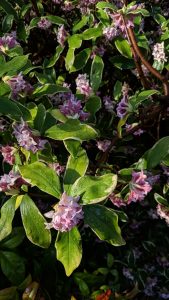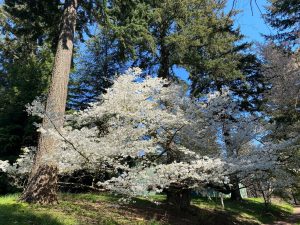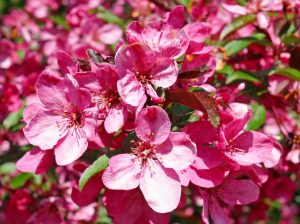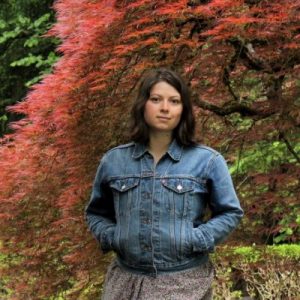Springtime has arrived in Portland, when a quick jaunt around your neighborhood will acquaint you with a variety of flora and fauna eager to soak up the intermittent sunshine. If you are like me, you have discovered a new found freedom in these little walks around the block. Whether they are a daily ritual or a sporadic stretching of legs and minds alike, now is a great time to mingle and get to know your arboreal neighbors. While you are exploring your own neighborhood keep an eye (and nose) out for these fragrant species:
Variegated Winter Daphne (Daphne odora)


With clusters of white-pink flowers set against a vibrant green background and a floral potency extending well beyond a few feet, it’s difficult to walk by daphne without a glance and a quick sniff. Before blooming with a sweet scent (which is both dainty and clean) this shrub may seem unassuming with its variegated green leaves. The shrub can easily reach a size of 4 feet tall by 6 feet wide. By early March, funnel shaped flowers begin to bloom in clusters at the ends of the branches. Each individual flower has four petals, which transition from a stark white to hues of pink and purple as they near the end of their bloom cycle in May.
Humans aren’t the only group to appreciate this evergreen species; hummingbirds and butterflies are also common patrons. If you are on the hunt for daphne, keep an eye out for areas exposed to full to partial sun as this non-native is a favorite in home landscaping.
Yoshino ‘Akebono’ Flowering Cherry Tree (Prunus x yedoensis) and Shirofugen Flowering Cherry Tree (Prunus serrulata ‘Shiro-fugen’)


If you happen to be standing underneath boughs of delicate white or pale pink blossoms in the Pacific Northwest, there is a good chance it is either a Yoshino or Shirofugen flowering cherry tree. From the family Rosacecae, there are a variety of cherry tree species worldwide, with the most famous being the Japanese cherry tree commonly called sakura. Favored by honeybees and small song birds alike, these trees are able to reach heights of 25 feet and are equally likely to extend their branches 25-plus feet wide. The color palette for cherry flowers ranges from a delicate white to pale pink. The petals are small yet numerous with a range of 20 to 36 petals per flower. Though not as fragrant as daphne, cherry blossoms have a memorable floral scent. The Yoshino bloom period begins in March and extends to April. The Shirofugen is quick to follow with its bloom period starting in May and ending in June.
Cherry trees inhabit the grounds at Hoyt Arboretum, Portland Japanese Garden, Japanese American Historical Plaza at Tom McCall Waterfront Park, Laurelhurst Park, and University of Portland to name a few. Their tolerant nature to a variety of soil types makes them a popular candidate for planter strips and home landscaping centerpieces. There is a good chance of finding a cherry tree in your neighborhood!
Note: A few honorable mention cherry tree species, all April bloomers, include the Kanzan, Mt. Fuji, and Royal Burgundy flowering cherry tree.
Red Jewel Crabapple Tree (Malus ‘Red Jewel’) and Prairiefire Crabapple Tree (Malus ‘Prairiefire’)


Another neighborhood tree worth checking out is the crabapple tree. From the genus Malus, this species also includes the domesticated orchard apple. The crabapples themselves may not be as appealing as their larger cousins but pausing to appreciate the spring blossoms is a refreshing experience.
From a distance, crabapple trees may seem indistinct from other spring flowering trees (like the cherry tree). However, the deep reddish-pink hues of the larger, defined five-petaled crabapple flowers are hard to miss. These blossoms are relatively short-lived as they only last 10 to 30 days before expiring depending on the species. But while in bloom, they are a popular choice among bees, butterflies, and birds alike. Once the blossoms near the end of their lifespan the flowers morph into crabapple fruits over the summer months. The fruits eventually ripen through the fall and become a dark shade of red. The natural form of this tree is a pyramid shape with low hanging branches. In the northwest you are likely to come across either a Red Jewel or Prairiefire crabapple. Stout in stature, these trees are a common choice by municipalities for planter strips as they are unlikely to grow to heights beyond 20 feet, which disrupt power lines.
In honor of the vibrant natural environment here in the Pacific Northwest, don’t forget to take some time to say hello and perhaps thank you to the plants, trees, and critters keeping your neighborhood streets and backyards in bloom and fragrant this spring!
About the Author


